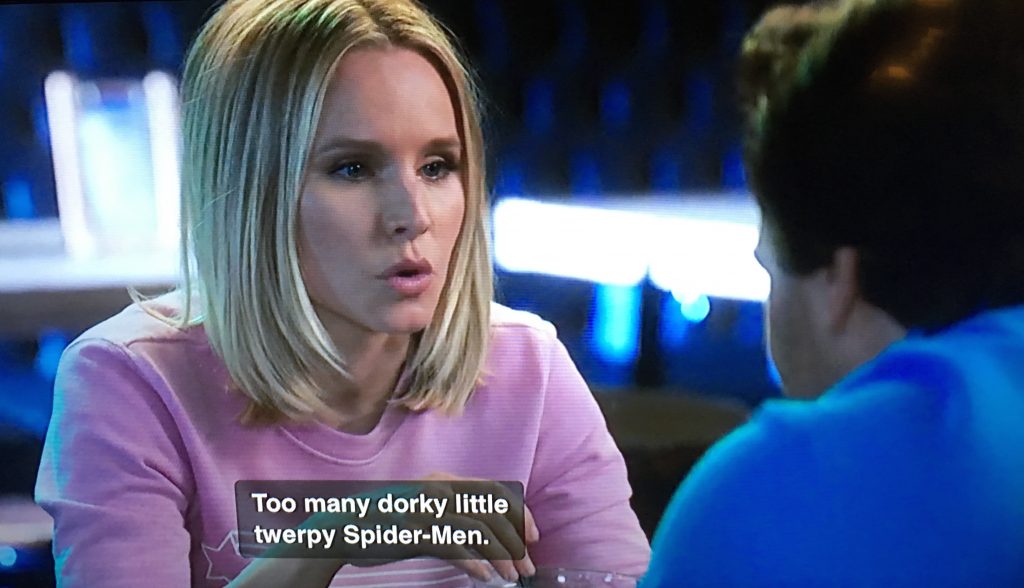Netflix’s Unbreakable Kimmy Schmidt recently released its final episodes, the second half of season 4. Created by Tina Fey and Robert Carlock, the show follows Kimmy Schmidt (Ellie Kemper), a woman who was kidnapped as a teenager and has spent the last 15 years living in an underground bunker, under the impression that the world had ended. Now free, Kimmy decides to move to New York City where she finds a cheap apartment with a quirky roommate and and even quirkier landlady (Tituss Burgess and Carol Cane) and employment as an assistant to a wealthy upper east side woman with too much time and money on her hands (Jane Krakowski). Jon Hamm makes recurring appearances as her charismatic kidnapper.
New York is very different from her small town in Indiana and Kimmy’s naiveté is demonstrated not only as a small town girl in the big city, but as an adult woman who missed growing up– her last experience in the outside world was as a teenager in the midwest. Unbreakable Kimmy Schmidt uses outrageous and surreal situations and characters to make its point. There are references and parodies throughout to other works, such as The Nanny Diaries (2007), Mary Tyler Moore, Sliding Doors (1998), and others. While it approaches being a millennial realistically (ie no money and poor job prospects), the show does not hesitate to create outrageous and seemingly impossible situations (ie sentient robots in the workplace). Still, Kimmy remains ever the optimist even as she learns more and more about the world she missed.
When I rewatched the snow in preparation for this post, I realized that I was half expecting it all to be a dream. While it doesn’t end that way, surrealism seems to win out in the end, giving everyone a happily ever after. Some plot threads are left unresolved, while others are tied up too quickly, but it’s not an entirely unsatisfying way to end the story.
At its core, Unbreakable Kimmy Schmidt is a story about social politics. While it often employs hyperbole and surrealism to get its point across, some of the situations are unfortunately not that far from reality. In another show, The Good Place, there’s a line in season 1 where a male character claims to have slept with a female, who denies it. His response: “Yeah, but who are they going to believe. Me or a woman?” This show similarly isn’t afraid to go there. Kimmy’s kidnapper almost goes free during trial because he is a charismatic white man.
Over and over, the show examines the effect race, gender, and sexuality have on your life. Jokes are constantly made about all three, with throwaway lines that treat horrible behavior like it’s normal, referring to behaviors or treatment that is accepted as fact based on stereotypes. There are also impossible situations presented as normal to make a point. For example, in the first season, Kimmy’s roommate, Titus, finds himself treated better as a werewolf than he did as a black man. Later, Kimmy’s employer– and later friend– Jacqueline is revealed to secretly be a Native American, rather than a white woman. As a wealthy white woman she is still shucked aside for a younger model by her husband, but as a Native American woman she is used later used for PR for her boyfriend’s family, the owners of the Washington Redskins.
The overall message has to do with Kimmy not wanting to accept things for how they are. Having missed 15 years of societal evolution, and lacking the cynicism of an adult, she brings to light things that everyone else takes for granted. Ever the optimist, Kimmy just wants to help people and change the world, eventually realizing that she can’t change the adults, but she can have an impact on the adults children will become. Much like the show does, Kimmy creates a fictional work (a novel) designed to hold up a mirror to society.
Interestingly, while Titus and Jacqueline find satisfying romantic relationships as the series close, Kimmy does not. (Nor does landlady Lilian, an older woman who continues to defy and meet expectation.) While she has a few romances through the series, for Kimmy, a happily ever after isn’t about finding a man. I actually found this jarring, which is disappointing that this is what we’ve come to expect instinctually. Meanwhile, gay serial dater Titus ends the series with a husband and children. There’s a message about happiness not necessarily being what you expect, but in the end I think each character met a satisfying end to their arc.

